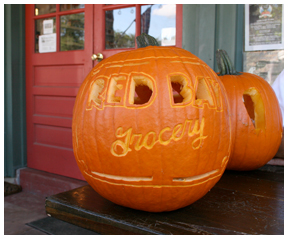
Helpful tips on finding the perfect pumpkin
Pumpkins and gourds were brought to America by settlers, but gourds likely came floating across the sea from Africa or we brought to South America by early Africans who came across the Atlantic. They not only were used as food, but the skins can be dried and woven. The first pumpkin pies were probably hollowed out pumpkins filed with milk and spices that were baked in a bed of ashes.
Pumpkins, which are members of the gourd family, along with watermelon and squash, are an American pastime each fall. In fact, according to the U.S. Census Bureau, 1.1 billion pounds of pumpkins were produced in this country in 2008, at a value around $141 million. While most families plan on getting a pumpkin this season, they are not always sure how to select a good one, or what to do once they have it home.
If you are in the market for a pumpkin, this season, keep the following shopping, usage and disposal tips in mind:
Selecting. To pick a good pumpkin, opt for one that is mature, feels firm, and has a rich orange color. Avoid ones that have scars and cracks. You can check the firmness by pushing on it with your fingernail. If it is mature, it should not scratch with the pressure.
Storing. Once you get the pumpkin home, you can store it for at least a month in a cool, dry place. If you want it to keep longer, you can take the pumpkin flesh out of its skin; it can then be frozen, dried or canned.
Using. There are a variety of uses for pumpkins. Many people opt to carve them into jack-o-lanterns. Others may decide to cook with them, which is a good option because they are loaded with antioxidants, beta-carotene, and vitamin A. They also provide fiber, potassium, and calcium. Pumpkins can be baked whole in the oven (set at 325 degrees, cooking time varies by size). Just be sure to poke holes in it first and then, when it’s finished, remove the skin, seeds and membrane.
The seeds can be roasted in the oven by tossing with some oil and laying a single layer on a baking sheet for about 12-15 minutes at 250 degrees. Pumpkin can also be used to make pies, pancakes, muffins, soups, and variety of other tasty recipes. A quick online search can net a wide array of pumpkin recipes. If you want to carve your pumpkin but still get some nutritional benefits, either carve it and toast the seeds, or opt to decorate it with non-toxic paint so you can still bake it afterward.
Discarding. If you go the route of creating a jack-o-lantern, this season, you may be wondering what to do with it once the festivities have moved on. Composting it makes a great option if you or someone you know has a garden. You can also check into donating it to local animal farms, or see if your city is collecting them for recycling purposes.
If you do not have a pumpkin in your garden, the gourds can be purchased locally at stores and stands such as the Red Bay Grocery on 8704 Highway 81 S, Red Bay, Florida 32455, or the Methodist Church’s pumpkin patch next to BankTrust Bank on Highway 331 in DeFuniak Springs, or the Seaside Farmer’s Market on Saturdays in Santa Rosa Beach.
Information courtesy WZEP AM 1460 – Walton-Holmes Radio. http://www.wzep1460.com
